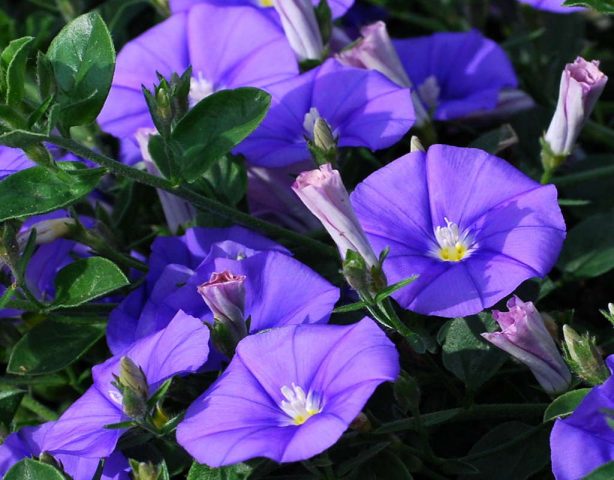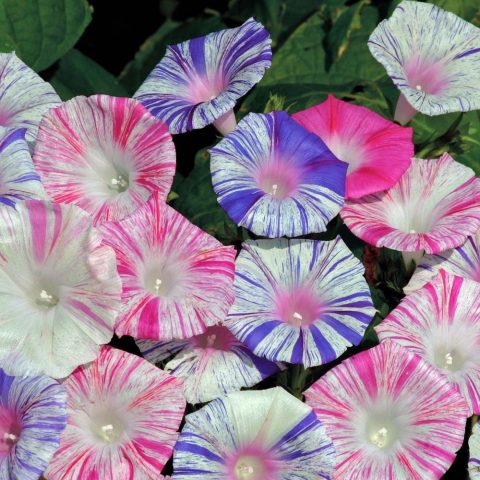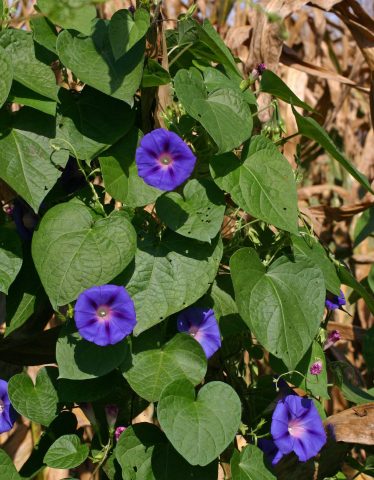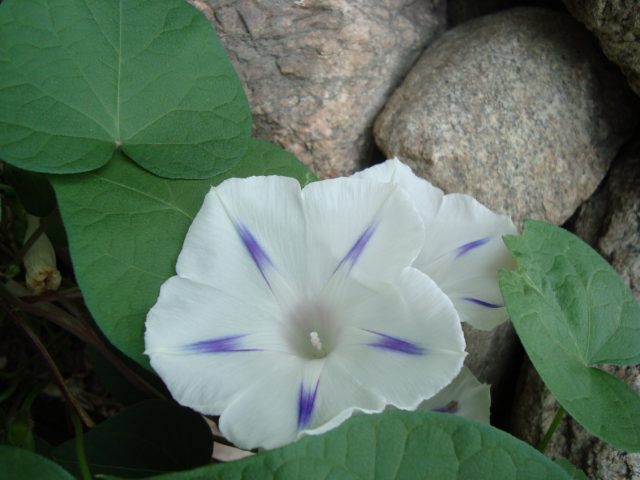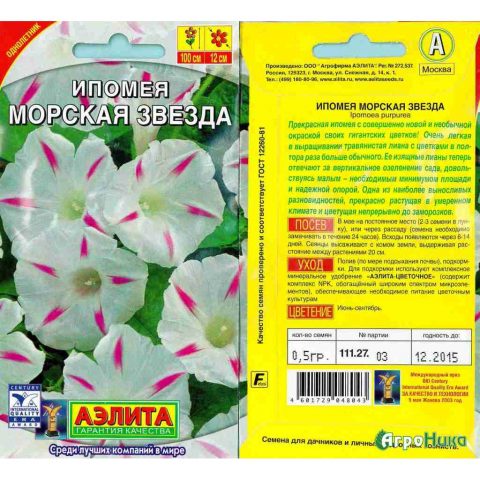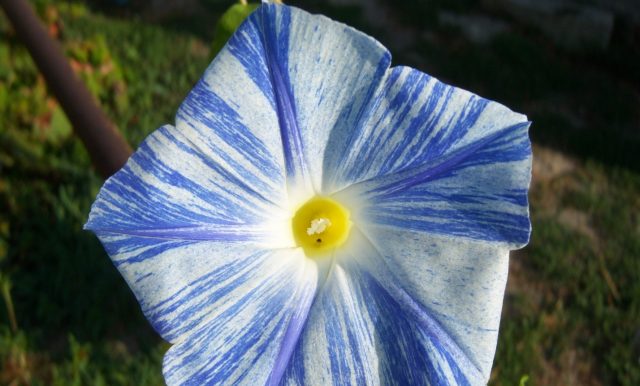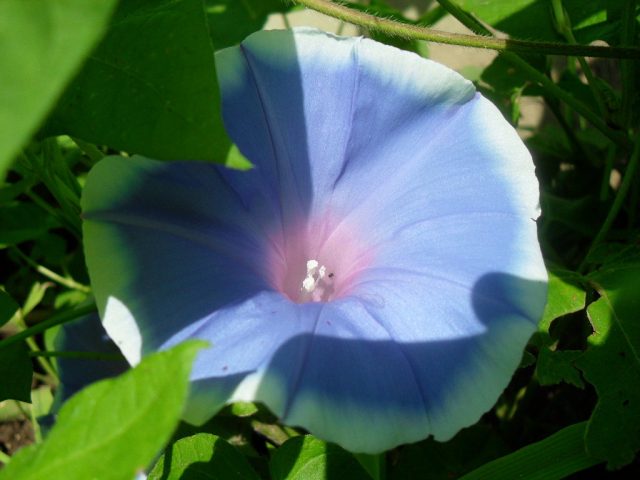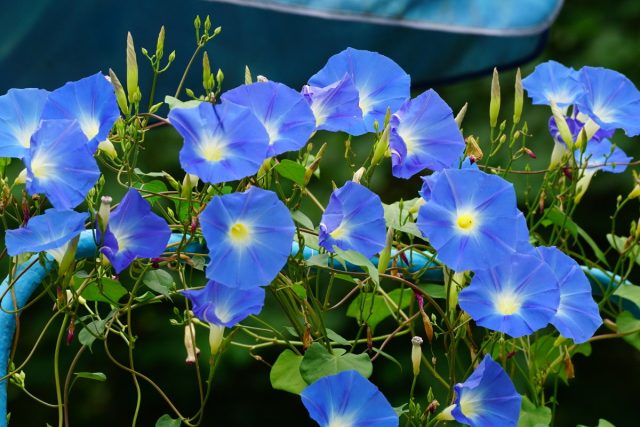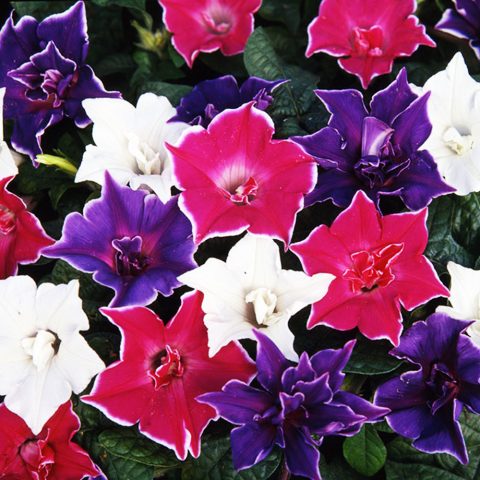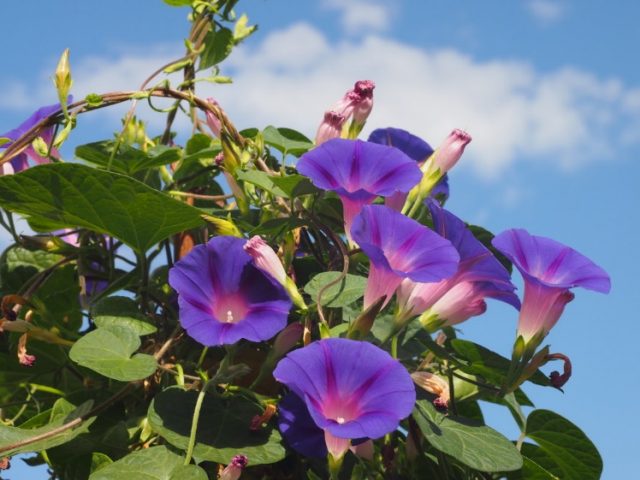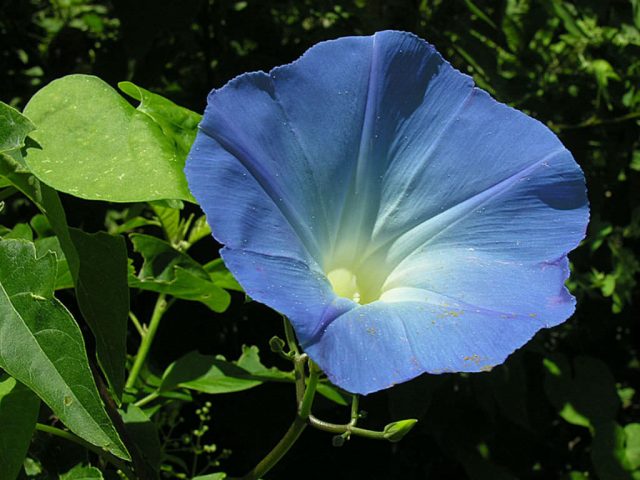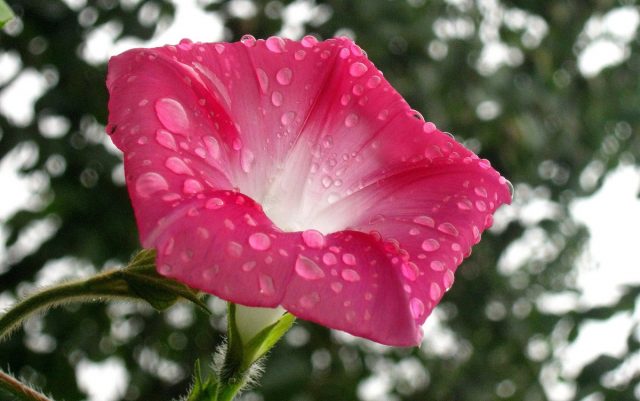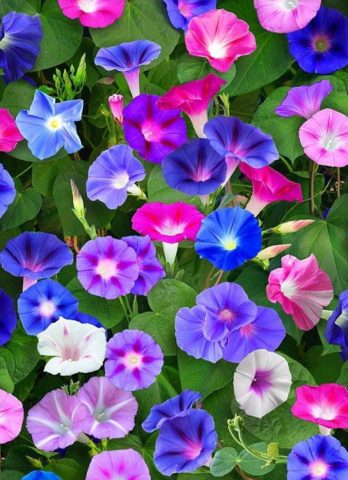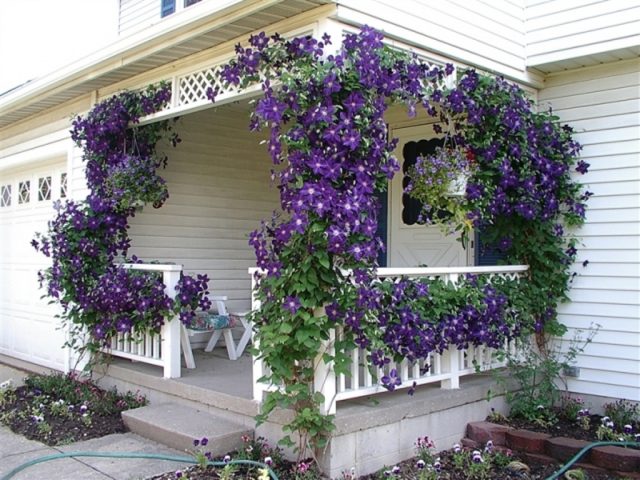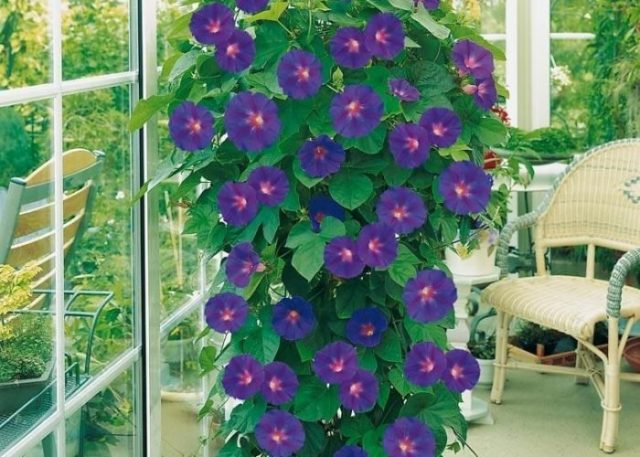Content
Ipomoea Purpurea is a popular, fast-growing annual plant. Its large bright flowers will serve as an excellent decoration for a summer cottage and will delight the eye throughout the whole summer - until late autumn.
General description of the species
Ipomoea purpurea is an ornamental herb that belongs to the Bindweed family. His homeland is Central and South America.
Ipomoea Purple is famous for its rapid growth of shoots: depending on the climate, in a short time they reach a height of 4 to 7 m, capturing the entire proposed space, and in one night they can twine around a low support. The longer the warm season lasts, the more the morning glory is drawn out.
The shoots of the plant are branched and long, covered with hairs. On a curling stem with a characteristic short pubescence, there are bright green, cordate, pointed leaves with oblong petioles. The length of the petioles is up to 12 cm, the leaves grow from 4 to 18 cm in length and width. They also have harsh pubescence.
On a small peduncle, one by one, there are large funnel-shaped flowers up to 6 cm in diameter.For their violet-red hue, the plant got its name. The color of the flowers can be very diverse: pink, crimson, purple, crimson or purple. There are both monochromatic and striped, variegated, terry colors. The internal pharynx is most often white. The flower is delicate, naked, without hairs, consists of 5 fused petals.
The photo of Ipomoea Purple shows a mixture of flowers of various shades.
Ipomoea Purple blooms profusely from June to the first frost. Flowers are highly light sensitive and live only a day. The petals open in the early morning and close when the midday sun gets too hot for them. In cloudy and cloudy weather, the flowers remain open throughout the day. In extreme heat, on the contrary, they open in the late afternoon.
Ipomoea Purpurea bears fruit in a three-nested capsule with seeds inside. Seeds 5 - 7 mm long, glabrous, black or light brown. The seed box contains 2 to 4 seeds.
As you can see from the photo, Ipomoea Purple is quite compact and does not take up much space, since it grows vertically.
Ipomoea Purple is unpretentious to the composition of the soil, but loves fertile, loose soils more. Growing in tropical and subtropical climates will be ideal conditions for her, but gardeners successfully cultivate morning glory in central Russia.
Ipomoea grown in the middle lane are annuals, since they are not able to survive severe frosts. However, under ideal conditions, Ipomoea Purpurea can grow for several years.
The plant prefers areas that are well lit and sheltered from the wind. In the shade, the decorativeness of the plant decreases: the flowers of the morning glory fade and become rare. The ideal location is the south-east and south-west side. As the morning glory grows, it needs support, which it will subsequently braid.
Ipomoea Purple grows well and develops in a warm, humid climate, frosts are detrimental to it.She does not tolerate air temperatures below 5 oC. During dry periods, it needs to be sprayed with a spray bottle, watering and liquid fertilizers.
Varieties
Gardeners prefer such varieties of Ipomoea Purple as Ultraviolet, Crimson Rambler, Beauty of Moscow, Blue Venice, Maura, Caprice, Milky Way, Venice Carnival.
Other popular varieties:
- Scarlett O'Hara... The variety is distinguished by bright crimson-pink flowers with a white heart, 7-10 cm in diameter, blooms profusely.
- Milky Way... Tall plant (up to 4 m), white flowers with purple-blue stripes.
- Starfish... A low liana (up to 1 m) with flowers 12 cm in size, painted white with five bright pink stripes repeating the shape of a star.
- Grandee... Height about 2 m. Flowers 12 cm in diameter. The inner pharynx is not white, but pale pink. The color itself is dark purple.
- Flying saucer... One of the varieties with the largest, up to 15 cm, blue-white flowers. The height reaches 2.5 m.
- Call... Delicate bluish-lilac flowers 12 cm with a pink center and white border. One of the lowest lianas, grows up to 1 m.
- Giselle... The variety is distinguished by long and abundant flowering. The flowers are large (about 15 cm), lilac-blue.
- Kiyosaki... The variety is characterized by a spectacular appearance. Height up to 2.5 m. Small corrugated flowers (up to 5 cm in diameter). Their color can be white, deep purple or purple with a white tint around the edges.
- Night... Bright purple flowers with white inner fauces. It grows up to 3 m in length.
- Blue sky... Light blue flowers up to 10 cm in diameter. Height 2 m.
- the Red Star... The variety reaches 3 m in height. Red-pink flowers with white blotches in the middle.
However, the most famous varieties of Ipomoea Purple remain the Paradise Stars and Star Waltz.
Star waltz
Seeds produced by the agrofirm "Aelita". As you can see from the photo, the variety Ipomoea purple Star Waltz blooms with large funnel-shaped flowers up to 12 cm in diameter. The stem length can reach 3 m.
The photo also demonstrates that the variety Ipomoea Purple Star Waltz is characterized by a mixture of flower colors. On one plant, they can be of several shades at once: blue, light blue, snow-white, pink and purple. It is thanks to this that the variety is very popular among summer residents and gardeners.
The flowering period lasts from July to September. For its abundance and duration, it is important to water, weed, loosen and fertilize the plant in a timely manner with the help of mineral dressings.
It is recommended to plant seeds outdoors at the end of May.
Heavenly stars
Ipomoea Purple Paradise stars is also distinguished by a mixture of colors. On one liana, beige, pink, purple, bright blue and pale blue flowers appear at the same time.
The flower of Morning glory Purple Paradise stars, thanks to its bright, large foliage and long abundant flowering, will serve as an excellent decoration for a summer cottage: a liana can cover fences and walls with a lush green carpet.
Planting seeds of Ipomoea Purple Star of Paradise in open ground begins in spring, in April, when the average daily temperature rises above 10 oC.
Breeding methods
Most often, Ipomoea Purple is propagated by seeds. You can buy them at a garden store or assemble them yourself.
Harvesting seeds of Ipomoea Purpurea begins in the fall. It is important to wait until the bolls are fully ripe, which occurs a month after the flowers wither. The boxes are dried until they crack, the seeds are separated, wrapped in paper bags and stored in a dark, dry, well-ventilated place until spring.
The plant is propagated using cuttings. To do this, an incision is made at an angle of 45 degrees on branches 15 - 20 cm long with 2 internodes. The incision should be approximately 2 cm below the knot. The lower leaves must be removed, and then put the cutting in a container with clean, settled water.
Cuttings of Ipomoea Purpurea are kept at room temperature until the first roots appear. After that, they need to be transplanted into the ground. The rooting process takes 1 to 2 weeks. Fertilization by Kornevin will not be superfluous.
Planting and care rules
In southern regions with a warm climate, where spring frosts are replaced by warmth already in April, the seeds of Ipomoea Purple are immediately planted in open ground.
Since it takes about three months from the moment of planting the morning glory to the opening of the first flowers, gardeners in Siberia and in central Russia prefer to grow seedlings. Planting is carried out from early March to April. In such a climate, sowing seeds in open ground may be too late, and the morning glory will not have time to bloom, or the first flowers will appear towards the end of the season.
The soil for Ipomoea Purple must be loose and nutritious, contain mineral and organic substances. The following soil composition is best suited for young seedlings:
- 2 pieces of leafy land;
- 1 part coconut fiber
- 1 part peat;
- 1 part vermiculite.
Planting and caring for seedlings of Ipomoea Purple: photo, step-by-step instructions.
- In the spring, before planting, seed preparation begins. They are soaked for 24 hours in water at room temperature.
- After swelling, several Ipomoea seeds are sown in small pots to a depth of about 2 cm. The soil must first be moistened.
- In order for the sprouts to sprout as early as possible, the pots are covered with foil on top and the temperature in the room is maintained at about 18 oC. Every day you need to remove the film and air the seedlings.
- The first shoots of morning glory should appear in 2 weeks. After the appearance of the fourth leaf, the seedlings are dived and planted one by one.
- When the sprouts reach a height of 15 cm, it is necessary to build a small support for them.
- Seedlings are transplanted into open ground, when during the week the air temperature at night does not drop below 5 oC. The distance between the shoots must be at least 25 cm.
When planting seeds in open ground, scarification is first performed. For this, the outer shell is damaged and the seeds are left in warm water for a day.
Landing is carried out at a daytime air temperature above 16 oC, the ground should be well warmed up. Seeds are planted in several pieces in holes 2 - 3 cm deep at a distance of 25 cm from each other and slightly moisten the soil.
When choosing a place for planting, it should be remembered that the plant loves well-lit by the sun, sheltered from the wind. Liana prefers slightly acidic, light soil. The site can be prepared in advance by adding the following mixture to the ground:
- 4 parts of peat;
- 2 pieces of sand;
- 1 part humus.
Follow-up care
Care after planting in open ground includes fertilizing and regular watering. During the period of growth and formation of flowers, Ipomoea Purple is actively watered, without waiting for the drying out of the earth in the root zone. With the approach of autumn, watering is reduced.
Ipomoea Purple is fed every 2 - 3 weeks, preference is given to fertilizers based on potassium and phosphorus. It is recommended to periodically loosen and mulch the soil.
With the onset of frost, Ipomoea Purple is completely removed from the site. The plant is sometimes brought into a warm room for the winter, then it can be used for cuttings in the spring.
Disease and pest control
Ipomoea purpurea can be affected by the following diseases.
- Root or stem rot... In areas of the plant, dark brown foci are formed. The cause of the disease is the fusarium fungus.Not amenable to treatment, the plant must be dug up and burned.
- Soft rot... The characteristic feature is the softened parts of the stem. In this case, morning glory also has to be removed and burned.
- Black rotcaused by a fungus. The stem is covered with dark spots, from which a pink liquid is released. Fungicide treatment will help save the plant.
- White rust... It is characterized by the appearance of small rounded spots with a white coating of fungus. The affected parts of the plant are removed. Ipomoea is treated with Fitosporin solution.
- Anthracnose... Occurs with excessive watering, growing brown spots appear on the leaves. The affected foliage is removed, the soil and the plant are treated with a fungicide.
Application in the design of the site
Landscape designers often use Ipomoea for vertical landscaping, the plant serves as a wonderful decoration for gazebos, arches, fences, fences and walls. With its help, you can hide all the shortcomings of summer cottages.
Ipomoea Purple looks good in combination with climbing plants: girlish grapes, tunbergia, clematis and kampsis. When planted next to fruit trees, the branches of the morning glory will twine around the trunk with an interesting pattern, making it a blooming work of art.
Conclusion
Purple morning glory is an ornamental plant that many gardeners and landscape designers love for its simplicity in care and a bright, attractive appearance. Liana is able to transform and make even the most unremarkable corner in the garden unique.
